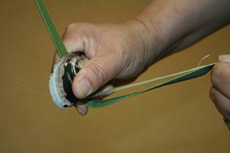Innovative new uses for flax fibre
Victoria University research on preventing deterioration of some of New Zealand’s oldest Māori cloaks has revealed potentially valuable anti-fungal properties in harakeke, or native flax.

Victoria University research on preventing deterioration of some of New Zealand’s oldest Māori cloaks has revealed potentially valuable anti-fungal properties in harakeke, or native flax.
Victoria's Associate Professor of Chemistry Dr Gerald Smith says that he began researching the properties of harakeke to find ways of stabilising the flax fibres in old Māori cloaks, which become brittle after exposure to light and humidity over time.
"As well as finding a way of halting this deterioration, we also found that the enhanced resistance some harakeke have to fungal growth means it could ultimately find new uses in conservation and textiles - as well as in packaging that would prevent food from spoiling."
Long term, says Dr Smith, the research holds promise for reviving New Zealand’s flax industry, which was a significant earner until the advent of synthetic fibres that use non-renewable material resources.
Landcare Research’s Sue Scheele, a leading harakeke expert, was able to provide different types of harakeke from New Zealand’s national collection to test.
Dr Smith says they found that harakeke has a particularly high content of a type of sugar polymer called hemi-cellulose, which results in the production of acetic acid causing deterioration of fibres.
"It’s known as the 'vinegar syndrome', and is a menace in the museum environment - because as well as accelerating damage on the item producing it, it is volatile and can float off and affect other exhibits. Another big problem we found is with fibres that were dyed black. The dye was usually made from a mud rich in iron salts, called paru, which also contains acidic materials."
As part of her Victoria University Master's project, Te Papa Conservator Rangi Te Kanawa worked with Dr Smith to develop a treatment for the affected fibres. The treatment, which is sprayed on, uses sodium alginate and zinc acetate to bind the harakeke fibres together, neutralising the acid and slowing the deterioration.
A number of the cloaks in the exhibition titled Kahu Ora│Living Cloaks currently showing at Te Papa have undergone the treatment, and it is also being used by conservators in other parts of the world.
Investigating the make-up of harakeke fibres also led the researchers to discover that they produce coumarin, a fragrant chemical compound that we can smell in the aroma of freshly cut grass, which has anti-fungal properties and repels pests.
Dr Smith says that they also identified the presence of a number of metal ions in harakeke fibres which could also be contributing to its anti-fungal properties. "We know the anti-fungal properties are there, but we don’t yet fully understand the chemistry or how to control or enhance those properties."
Dr Smith says the research has the potential to lead to a range of innovative new products.
"One possibility is the development of innovative textiles that are protected from fungal attack by natural, environmentally-friendly means. Another is the development of packaging for food such as fruit which spoils easily.
"Many existing anti-fungal treatments are harmful both to health and the environment, so there is strong demand for effective, natural and volatile anti-fungal agents that we can use in food storage."
Applications are also anticipated in the museum sector for storing and protecting heritage items.
Dr Smith's research was funded by the Foundation for Research Science and Technology (now the Ministry of Business Innovation and Employment) through the Te Tipu o te Wānanga scheme. For more information, contact Associate Professor Gerald Smith.
